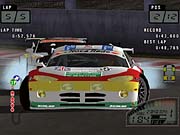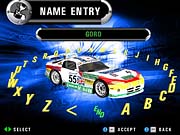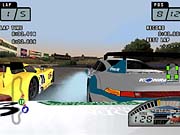If you want to milk something, you'd best make sure it has milk to give. Le Mans 24 Hours has been around in some form or another since late 1999 when Infogrames inked a North American distribution deal with the game's original developer, the British studio Euthechnyx, and immediately relabeled it Test Drive Le Mans to fit within its newly acquired Test Drive franchise. It has since appeared on a number of platforms and in a variety of incarnations and has been re-re-released for the PC under its original European title. Unfortunately, no number of guises can change the fact that Le Mans makes a far better console game than it does a computer game. Despite the work of a new developer, Australia's Melbourne House, and a modified physics engine that admittedly makes it slower and more realistic, Le Mans has awkward control, horridly clumsy interfaces, and several annoying console game conventions. In short, Le Mans 24 Hours has been milked over and over again without ever receiving a serious face-lift for the PC, and that's just not good enough compared to today's top-level computer racers.

It won't take you long to realize that Infogrames has done minimal work to ready a game for the PC that was clearly designed with consoles in mind. For instance, Le Mans 24 Hours' menu system is shockingly inefficient. The game forces you to access nearly a dozen minimally adorned interfaces just to set up basic parameters and enter an event. It lets you use your mouse for some general selections but permits keyboard-only commands for more specific options such as garage modifications. And should you exit the game and restart it later, you must make sure you've entered your preferences and exited the preference interfaces in a certain way, or the game may not have saved them for you. And even then you'll be forced to endure the "launcher" and "3D card setup" windows each time you play. That some of the game's "cancel" buttons actually mean "accept" and other "cancel" buttons are actually "back" buttons is strangely inconsistent. Worse still, the Le Mans race loading and unloading routine creaks along at glacial speed. Even on an extremely fast computer, you can expect waits of 20 seconds or more every time you enter or exit an event. Alternate install methods do nothing to alleviate the situation, because there are no alternate install methods. Watching that green progress bar creep across the bottom of the screen will quickly become one of your least favorite pastimes, as will watching the game attempt to roll its credits every time you win one of its many championship rounds.
If and when you do come to grips with Le Mans 24 Hours' obvious menu quirks, you will see that the game is indeed versatile. Featuring the same sleek, high-powered close-wheeled production and purpose-built GT and prototype cars that frequent the famed round-the-clock 24 Hours of Le Mans, the game delivers a variety of racing modes and options. Beginners may wish to avail themselves of the quick race mode, which lets them select a track from 13 real-life circuits or variations thereof, choose one of 70 available automobiles, and compete against others in an abbreviated race length. More-experienced drivers will undertake the championship mode, where they'll compete against novice drivers in the three-race rookie GT series before moving to more prestigious events involving longer races, better drivers, and variables such as inclement winter weather and pit stops. Winning each round in the championship mode unlocks the increasingly faster, more capable cars required in succeeding stages.

Veteran racers will undoubtedly want to test their mettle at the game's namesake racetrack. In this mode, drivers will need to employ all they've learned in prior modes and intelligently deal with variables such as tire wear and changes, fuel stops, and other prerace and midrace options. The Le Mans mode is definitely the most difficult and the most grueling, particularly if you opt for the actual race distance of 24 real-time hours. Even if you select compacted race lengths of 10, 24, or 240 minutes, the game automatically turns day into night and night back into day. The game will also subject you to environmental situations such as rain and full-blown storms, both of which may be confined to just a section of the monstrous 13.6-kilometer circuit.
In fact, Le Mans is most graphically impressive when displaying these time-of-day and weather variables. As daylight slowly transposes into dusk, twilight, and evening, the ambient lighting moves from a warm, orange glow to a dusky gray and finally to a moonlit night. Thankfully, the game never envelops you in complete darkness even during an evening rainstorm--the glow of your own headlights,you're your competitors' headlights and taillights, and the trackside lamps in grandstands and various peripheral objects help keep things workably illuminated. The lighting itself is downright gorgeous when near your vehicle but strangely accentuated and indistinct when viewed from a distance.

Otherwise, Le Mans puts on a compelling but sometimes-inadequate graphics show. The actual circuits are nicely rendered and filled with interesting elevation changes, twists and turns, and enough pavement variances and motion-blur effects to effectively suggest an impressive sense of speed. The game's trackside scenery is believable but not overly dense or spectacular, yet the clouds overhead and the dust plumes created from offtrack dalliances are eerily convincing. The fully decaled vehicles, which look just fine from the various alternate cameras of the postrace replay, seem rudimentary and bereft of reflections and lighting effects when you're racing with them. Drivers' heads bounce realistically up and down and back and forth in accordance with vehicular movements and turn to peer into upcoming turns. Unfortunately, the game does not feature rearview mirrors, instead opting for the antiquated and inefficient "look back" function.
Le Mans delivers a mixed audio experience. Although tires squeal and chirp with admirable realism during heavy braking and hard cornering and thus offer a good indication they've been pushed beyond acceptable limits, the motor purrs rather than growls and features virtually no bottom-end frequencies. Furthermore, your own engine notes are lost among those of the other cars, with no way to adjust the settings. Ambient music is available for those who want to listen to tunes as they carve their corners, and the gathered throng of spectators reacts to positive and negative events, unleashing a cheer or a groan when applicable.
Driving a Le Mans car is a puzzling experience. On the upside, it does behave according to its described strengths and weaknesses. If the game tells you that your selected vehicle has good acceleration or particularly strong handling, it acts as such on the track. If you've dialed in more or less downforce, lessened the fuel load, or slipped on some soft tires, you will feel the difference. What's more, the AI drivers are very good, keeping needless bumping to a minimum while exhibiting authentic aggressiveness and capabilities. Long multilap dices are not uncommon. Tires degrade as races wear on, slipstreaming increases top speeds, and cars bounce about when running over rough pavement.

Yet the actual art of driving a racecar has somehow been lost on the Le Mans programmers. In short, the game does not deliver a believable driving experience. Rather than motoring along on top of the track, you'll feel more like you're somehow magnetically attached to a long rail that runs down the center of the pavement. When turning, even just to make a quick pass on a straightway, your car reacts sluggishly and acts as if it's doing something it wasn't intended to do. When taking a real corner, you're practically forced to park the thing before cranking the wheel, otherwise you'll simply continue in a semistraight path right into the wall or grass. Even if you take the time to modify the game's control device parameters from their highly dubious default settings, a vehicle in Le Mans 24 Hours remains an unrealistic oddity.
These physics quirks force you to adopt not only an unusual driving style, but several questionable tactical maneuvers as well. In Le Mans, you'll inevitably use other cars to stop your own, smacking them seven ways from Sunday in the corners and taking full advantage of the game's unfortunate "no damage" policy. In fact, you may be able to transpose the front of your car into the side of theirs without any effect whatsoever, so you'd best make sure to bump 'em hard. Whatever you do, make sure you don't put four wheels off the pavement or you'll slow faster than if you'd jammed on the binders. Clearly then, cutting even the tiniest of corners or jumping the curb is a strict no-no.
With an MSRP of just $29.99, Le Mans 24 Hours is not totally unlikable. Nevertheless, it has experienced a variety of revisions and exhibits a dated feel, a distinct console facade, and quirky physics. That its multiplayer support is restricted to two drivers via split screen on a single computer comes as no surprise. Indeed, it is high time for Infogrames to milk something else--because this game's pretty dry.